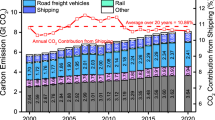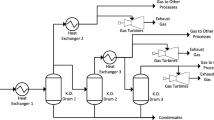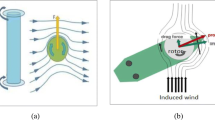Abstract
Nowadays alternative and innovative energy recovery solutions are adopted on board ships to reduce fuel consumption and harmful emissions. According to this, the present work compares the engine exhaust gas waste heat recovery and hybrid turbocharger technologies, which are used to improve the efficiency of a dual-fuel four-stroke (DF) marine engine. Both solutions aim to satisfy partly or entirely the ship’s electrical and/or thermal loads. For the engine exhaust gas waste heat recovery, two steam plant schemes are considered: the single steam pressure and the variable layout (single or dual steam pressure plant). In both cases, a heat recovery steam generator is used for the electric power energy generation through a steam turbine. The hybrid turbocharger is used to provide a part of the ship’s electric loads as well. The thermodynamic mathematical models of DF engines, integrated with the energy recovery systems, are developed in a Matlab-Simulink environment, allowing the comparison in terms of performance at different engine loads and fuels, which are Natural Gas (NG) and High Fuel Oil (HFO). The use of NG always involves better efficiency of the system for all the engine working conditions. It results that the highest efficiency value achievable is 56% at 50% maximum continuous rating (MCR) engine load.
Similar content being viewed by others
Abbreviations
- AC:
-
air cooler
- AF:
-
compressor inlet air filter
- AFC:
-
Annual Fuel Cost
- AMC:
-
Annual Maintenance Cost
- Ae :
-
pipe wall external area (m2)
- Ai :
-
pipe wall internal area (m2)
- Am1 :
-
pipe wall logarithm area (m2)
- BV:
-
bleed valve
- C:
-
turbocharger compressor
- CAPEX:
-
Capital Expenditure
- CII:
-
Carbon Intensity Indicator
- CP:
-
evaporator circulating pump
- DF:
-
Dual-Fuel engine
- E:
-
Economizer
- ECA:
-
Emission Control Area
- EEXI:
-
Energy Efficiency Existing Ship Index
- EG:
-
Electric generator
- EM/G:
-
Electric Motor/Generator
- ENG:
-
Engine
- EV:
-
Evaporator
- FP:
-
Feed Pump
- GD:
-
Gas Deviator
- GHG:
-
Green House Gases
- HFO:
-
Heavy Fuel Oil
- HP:
-
High Pressure
- HRSG:
-
Heat Recovery Steam Generator
- HTC:
-
Hybrid Turbocharger
- HWT:
-
Heat Water Tank
- h :
-
specific enthalpy (kJ/kg)
- he :
-
external pipe convective heat transfer coefficient (kW/(m2 K))
- hi :
-
internal pipe convective heat transfer coefficient (kW/(m2 K))
- k :
-
wall thermal conductivity (kW/(m K))
- IC:
-
Investment cost
- ILV:
-
Isenthalpic Lamination Valve
- IMO:
-
International Maritime Organization
- JW:
-
Jacket Water
- LP:
-
Low Pressure
- MCR:
-
Maximum Continuous Rating
- MFP:
-
Main Feed Pump
- M:
-
mass flow rate (kg/s)
- N:
-
shaft speed (r/min)
- n:
-
Number of years
- NCR:
-
Normal Continuous Rating
- NG:
-
Natural Gas
- OPEX:
-
Operational Expenditure
- P :
-
Power (kW)
- Q′ :
-
shaft torque (Nm)
- p:
-
pressure (Pa)
- P :
-
Power (W)
- R:
-
Discount rate
- Re :
-
external pipe thermal resistance (K/kW)
- Ri :
-
internal pipe thermal resistance (K/kW)
- SC:
-
SCavenger
- SCO:
-
Steam COndenser
- SCP:
-
Steam Condensing Pump
- SD:
-
HRSG evaporator Steam Drum
- SH:
-
SuperHeater
- SSC:
-
Steam Service Condensing outlet
- SSS:
-
Ship Steam Service
- ST:
-
Steam Turbine
- s :
-
pipe wall thickness (m)
- T:
-
temperature (K), turbocharger turbine
- TC:
-
TurboCharger
- V:
-
Valve
- VL:
-
Variable Layout
- VTNA:
-
Variable Turbine Nozzle Area
- WHR:
-
Waste Heat Recovery
- 0s:
-
heat water tank outlet
- 0s COND:
-
steam condensing pump outlet
- 0sc:
-
main feed pump outlet
- 00sc:
-
scavenger water outlet
- 1g:
-
turbocharger turbine outlet
- 1s:
-
economizer water outlet
- 2g:
-
evaporator gas inlet
- 2s:
-
evaporator water inlet
- 2′ s:
-
evaporator steam outlet
- 3g:
-
economizer gas inlet
- 3s:
-
superheater steam outlet, steam turbine inlet
- 3sd:
-
HRSG stean drum steam outlet
- 4g:
-
HRSG gas outlet
- 4s:
-
vacuum condenser inlet
- 5s:
-
steam condensing pump
- 6s:
-
jacket water outlet Subscripts
- a :
-
Air
- amb:
-
Ambient
- cs:
-
Control Signal
- e :
-
External
- el:
-
Electric
- E:
-
Engine
- EM/G:
-
Electric Motor/Generator
- f :
-
Fuel
- g :
-
Gas
- HP:
-
High Pressure
- i:
-
Inlet, Internal
- LP:
-
Low Pressure
- MF:
-
Fuel Mass
- o:
-
Outlet
- s:
-
Steam, Signal
- pp:
-
Pinch Point
- T:
-
Turbine
- TC:
-
Turbocharger
- w:
-
Wall
References
Akiliu BT, Gilani SI (2010) Mathematical modeling and simulation of a cogeneration plant. Applied Thermal Engineering, 30(16): 2545–2554. https://doi.org/10.1016/j.applthermaleng.2010.07.005
Altosole M, Laviola M, Trucco A, Sabattini A (2014) Waste heat recovery systems from marine diesel engines: comparison between new design and retrofitting solutions. In Proceedings of the 2th International Conference on Maritime Technology and Engineering (MARTECH 2014), Lisbon, Portugal, 15–17. https://doi.org/10.3390/en10050718
Altosole M, Benvenuto G, Campora U, Laviola M, Zaccone R (2017) Simulation and performance comparison between diesel and natural gas engines for marine applications. Proceedings of the Institution of Mechanical Engineers, Part M: Journal of Engineering for the Maritime Environment, 231(2): 690–704. https://doi.org/10.1177/1475090217690964
Altosole M, Campora U, Laviola M, Zaccone (2018a) Waste heat recovery from dual-fuel marine engine. In Maritime Transportation and Harvesting of Sea Resources, Vol. 1. Guedes Soares C, Teixeira AP Eds. Taylor & Francis Group, London, 79–86. https://doi.org/10.3233/978-1-61499-870-9-21.
Altosole M, Campora U, Laviola M, Zaccone R (2018b) High efficiency waste heat recovery from dual fuel marine engines. Technology and Science for the Ships of the Future. A. Marinò, V. Bucci, Eds. Proc. NAV, 21–28. Doi:10.3233/978-1-61499-870-9-21.
Altosole M, Benvenuto G, Campora U, Silvestro F, Terlizzi G (2018c) Efficiency improvement of a natural gas marine engine using a hybrid turbocharger. Energies, 11(8):1924. https://doi.org/10.3390/en11081924
Altosole M, Campora U, Donnarumma S, Zaccone R (2019) Simulation techniques for design and control of a waste heat recovery system in marine natural gas propulsion applications. Journal of Marine Science and Engineering, 7(11): 397. https://doi.org/10.3390/jmse7110397
Altosole M, Campora U, Vigna V (2020a) Energy efficiency analysis of a flexible marine hybrid propulsion system. In 2020 International Symposium on Power Electronics, Electrical Drives, Automation and Motion (SPEEDAM): 436–441. doi: https://doi.org/10.1109/SPEEDAM48782.2020.9161873
Altosole M, Benvenuto G, Zaccone R, Campora U (2020b) Comparison of saturated and superheated steam plants for waste-heat recovery of dual-fuel marine engines. Energies, 13(4):985. https://doi.org/10.3390/en13040985
Altosole M, Balsamo F, Campora U, Mocerino L (2021) Marine dual-fuel engines power smart management by hybrid turbocharging systems. Journal of Marine Science and Engineering, 9(6): 663. https://doi.org/10.3390/jmse9060663
Altosole M, Campora U, Mocerino L, Zaccone R (2022) An Innovative variable layout steam plant for waste heat recovery from marine dual-fuel engines. Ships and Offshore Structures. https://doi.org/10.1080/17445302.2022.2061769
Barreiro J, Zaragoza S, Diaz-Casas V (2022) Review of ship energy efficiency. Ocean Engineering, 257, 111594. https://doi.org/10.1016/j.oceaneng.2022.111594
Benvenuto G, Campora U, Laviola M, Terlizzi G (2017) Simulation model of a dual-fuel four stroke engine for low emission ship propulsion applications. International Review of Mechanical Engineering, 11(11): 817–824. https://doi.org/10.15866/ireme.v11i11.11929
Benvenuto G, Campora U, Laviola M, Zaccone R (2015) Comparison of Waste Heat Recovery Systems for the Refitting of a Cruise Ferry. Proceedings of the NAV.
Benvenuto G, Trucco A, Campora U (2014) Optimization of waste heat recovery from the exhaust gas of marine diesel engines. Proceedings of the Institution of Mechanical Engineers, Part M: Journal of Engineering for the Maritime Environment, 230(1): 83–94. https://doi.org/10.1177/1475090214533320
Choi CB, Kim YM (2013) Thermodynamic analysis of a dual loop heat recovery system with trilateral cycle applied to exhaust gases of internal combustion engine for propulsion of the 6800 TEU container ship. Energy, 58: 404–416. https://doi.org/10.1016/j.energy.2013.05.017
Cohen H, Rogers GFC, Saravanamuttoo HIH (1987) Gas Turbine Theory (Third Edition), Longman Scientific & Technical, Harlow, Essex, England
Dimopoulos GG, Kakalis NMP (2010) An integrated modelling framework for the design, operation and control of marine energy systems. 26th CIMAC World Congress, Bergen, Norway
Dotto A, Campora U, Satta F (2021) Feasibility study of an integrated COGES-DF engine power plant in LNG propulsion for a cruise-ferry. Energy Conversion and Management, 245: 114602. https://doi.org/10.1016/j.enconman.2021.114602
Dzida M (2009) On the possible increasing of efficiency of ship power plant with the system combined of marine diesel engine, gas turbine, and steam turbine, at the main engine-steam turbine mode of cooperation. Polish Maritime Research, 47–52. https://doi.org/10.2478/v10012-008-0010-z
Grimmelius H, Boonen EJ, Nicolai H, Stapersma D (2010) The integration of mean value first principle diesel engine models in dynamic waste heat and cooling load analysis. Proceedings of the CIMAC Congress. Bergen, Norway, 14–17.
DNV (2022) http://www.dnvgl.com/maritime/lng/current-price-development-oil-and-gas.html
IMO (2003) Assembly 23, Resolution A.963(23). IMO Policies and Practices Related to the Reduction of Greenhouse Gas Emissions from Ships, December 5.
IMO (2008) International Maritime Organization, Report of the Marine Environment Protection Committee (MEPC) on its Fifty-Seventh Session, 57th session, April 7 IMO (2020) International Maritime Organization, MARPOL Annex VI–Prevention of Air Pollution from Ships, National Workshop (virtual) on Ratification and Effective Implementation of MARPOL Annex VI, November 26
Ioannidis J (1984) Thermo Efficiency System (TES) for Reduction of Fuel Consumption and CO2 Emission. Aalborg AG: Copenhagen, Denmark
Ito K, Akagi S (1986) An optimal planning method for a marine heat and power generation plant by considering its operational problem. International Journal of Energy Research, 10(1): 75–85. https://doi.org/10.1002/er.4440100109
Jeong B, Oguz E, Wang H, Zhou P (2018). Multi-criteria decision-making for marine propulsion: Hybrid, diesel electric and diesel mechanical systems from cost-environment-risk perspectives. Applied energy, 230, 1065–1081. https://doi.org/10.1016/j.apenergy.2018.09.074
Livanos GA, Theotokatos G, Pagonis DN (2014) Techno-economic investigation of alternative propulsion plants for Ferries and RoRo ships. Energy Conversion and Management, 79: 640–651. https://doi.org/10.1016/j.enconman.2013.12.050
MAN 51/60DF Project Guide (2015) Marine, Four-stroke dual-fuel engine compliant with IMO Tier II / IMO Tier III
MAN B&W Diesel (2005) Thermo Efficiency System (TES) for Reduction of Fuel Consumption and CO2 Emission. Publ. No.: P3339161. Copenhagen, Denmark.
MAN Diesel & Turbo (2010) Thermo Efficiency System. Report 5510-0030-02, Copenhagen, Denmark
MIDAS (2022) www.coinmarketcap.com/it/currencies/midas-dollar.
Ono Y, Shiraishi K, Yamashita Y (2012) Application of a large hybrid turbocharger for marine electric-power generation. Mitsubishi Heavy Industries Technical Review, 49(1)
Rusman JD (2018) Charge air configurations for propulsion diesel engines aboard fast naval combatants. In Proceedings of the 14th International Naval Engineering Conference & Exhibition (INEC), Glasgow, UK, 2–4
Sharples J (2019) LNG supply chains and the development of LNG as a shipping fuel in Northern Europe. The Oxford Institute for Energy Study. https://doi.org/10.26889/9781784671266
Shiraishi K, Ono Y (2007) Hybrid Turbocharger with integrated High Speed Motor-generator. Technical Review: Mitsubishi Heavy Industries, Ltd, 44(1): 1–3
Shiraishi K, Ono Y, Sugishita K (2010) Development of large marine hybrid turbocharger for generating electric power with exhaust gas from the main engine. Mitsubishi Heavy Industries Technical Review, 47(3): 53–58
Shiraishi K, Ono Y, Yamashita Y, Sakamoto M (2015) Energy savings through electric-assist turbocharger for marine diesel engines. Mitsubishi Heavy Ind. Tech. Rev, 52(1): 36–41
Su Z, Ouyang T, Chen J, Xu P, Tan J, Chen N, Huang H (2020) Green and efficient configuration of integrated waste heat and cold energy recovery for marine natural gas/diesel dual-fuel engine. Energy Conversion and Management, 209, 112650. https://doi.org/10.1016/j.enconman.2020.112650
Theotokatos G, Rentizelas A, Guan C, Ancic I (2020) Waste heat recovery steam systems techno-economic and environmental investigation for ocean-going vessels considering actual operating profiles. Journal of cleaner production, 267, 121837. https://doi.org/10.1016/j.jclepro.2020.121837
Tien WK, Yeh RH, Hong JM (2007) Theoretical analysis of cogeneration system for ships. Energy Conversion and Management, 48(7): 1965–1974. https://doi.org/10.1016/j.enconman.2007.01.032
Völker T (2015) Hybrid propulsion concepts on ships Harbor Tug Description of harbor tug Load profiles for harbor Tug. Scientific Journal of Gdynia Maritime University, 11–16
Author information
Authors and Affiliations
Corresponding author
Ethics declarations
Competing interest The authors have no competing interests to declare that are relevant to the content of this article.
Additional information
Article Highlights
• Three different energy recovery systems are considered for the application to a DF four-stroke marine engine (MAN 4-stroke DF 516018V) and two different fueling: natural gas and heavy fuel oil
• The solutions can be applied in the maritime sector of hybrid turbocharge (HTC)
• Comparative analysis shows that the use of NG involves better energy efficiency of the system for all the engine working conditions
• The simultaneous use of the waste heat recovery (WHR) and WHR-variable layout plants with the HTC one produces a significant increase in ship management cost savings.
Rights and permissions
About this article
Cite this article
Campora, U., Coppola, T., Micoli, L. et al. Techno-Economic Comparison of Dual-fuel Marine Engine Waste Energy Recovery Systems. J. Marine. Sci. Appl. 22, 809–822 (2023). https://doi.org/10.1007/s11804-023-00368-0
Received:
Accepted:
Published:
Issue Date:
DOI: https://doi.org/10.1007/s11804-023-00368-0




